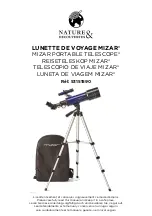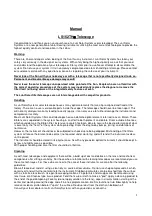
13
Continue using stars as guideposts in this way until you are at
the approximate position of the object you are trying to find
(Figure 9). Look in the telescope’s eyepiece, and the object
should be somewhere within the field of view. If it’s not, sweep
the telescope carefully around the immediate vicinity until the
object is found.
If you have trouble finding the object, start the star hop again
from the brightest star near the object you wish to view. This
time, be sure the stars indicated on the star chart are in fact
the stars you are centering in the eyepiece.
7. Terrestrial Viewing
The StarMax 102mm not only excels at astronomical observ-
ing, it’s great for terrestrial (land) viewing too. The equatorial
mount, however, is not well suited for land viewing due to its
motion about R.A. and Dec. axes instead of altitude (vertical)
and azimuth (horizontal) axes. Because of this, we recom-
mend removing the optical tube from the EQ-2 Mount and
placing it on an appropriate photo-style tripod. This is easily
done by rotating the thumb wheel clockwise on the mount’s
1/4"-20 adapter. Make sure to have a firm grip on the tube as
it releases from the mount. Now, connect the optical tube to a
photo tripod by threading the tripod’s 1/4"-20 shaft into the
hole in the tube’s mounting block.
The included mirror star diagonal, while preferred for astro-
nomical observing because of its viewing angle and better
resolution, is not optimal for land viewing because it inverts
images from left-to-right. We recommend purchasing an
optional 45° correct-image diagonal for terrestrial observing;
it provides a more comfortable viewing angle for land viewing
and an image that is oriented the same as the naked eye.
For terrestrial viewing, it’s best to stick with low power eye-
pieces that yield a magnification under 100x. At higher
powers, images rapidly lose sharpness and clarity due to
“heat waves” caused by Sun-heated air.
Remember to aim well clear of the Sun, unless the front of the
telescope is fitted with a professionally made solar filter and
the finder scope is covered with foil or some other completely
opaque material.
8. Photography
With an optional camera adapter, the StarMax 102mm
becomes a 1300mm f/12.7 telephoto lens for a single-lens
reflex camera. For long-distance terrestrial or astronomical
photography, you need only a T-ring for your specific camera
model. The T-ring attaches to your camera and threads onto
the StarMax’s eyepiece adapter (first remove eyepiece and
diagonal), coupling the camera body to the telescope.
Use the camera’s viewfinder to frame the picture. Use the
telescope’s focuser to focus the image.
You may want to consider using a remote shutter release
instead of the shutter release on the camera. Touching the
camera can vibrate the system and blur the resulting photo-
graphic image. Also, be sure to use a solid tripod.
9. Care and Maintenance
Transporting
The included soft carry case provides an excellent way to
transport the optical tube and its accessories. Remove the
tube from the mount by rotating the knurled thumb wheel on
the mount’s 1/4"-20 adapter. Make sure to have a firm grip on
the tube as it releases from the mount. To place the optical
tube in the case, the eyepiece, diagonal, finder scope and
bracket must be removed from the tube. When removing the
eyepiece and diagonal, remember to first loosen the securing
thumb screws. The finder scope and bracket can be removed
together by loosening the thumb screw on the tube’s dovetail
mount. Cover the front of the optical tube with the dust cover
and the rear opening of the eyepiece adapter with its cap.
Now place the tube in the case’s main compartment under-
neath the padded divider. The finder scope and bracket can
be placed on top of the divider as one unit. The eyepiece and
diagonal should be covered with their caps and placed in the
external compartments of the case.
It is not necessary to completely disassemble the mount to
transport it. It will be convenient to remove the accessory tray
(by unthreading the three wing screws) in order to fold the tri-
pod legs together. It may also be convenient to remove the
slow-motion control cables and counterweight shaft. Orion
offers an optional Padded Scope Case that will fit the entire
EQ-2 Mount.
Storing
If you give your telescope reasonable care, it will last a life-
time. Store it in a clean, dry, dust-free place, safe from rapid
changes in temperature and humidity. Do not store the tele-
scope outdoors, although storage in a garage or shed is OK.
Small components like eyepieces, diagonals, and other
accessories can be kept in the included carry case or in an
optional eyepiece case. Keep the dust cover on the front of
the telescope and cap the rear opening of the eyepiece
adapter. Also keep the finder scope caps on if you leave it
attached to the optical tube.
Cleaning the Tube
Your StarMax 102mm EQ telescope requires very little
mechanical maintenance. The optical tube is aluminum and
has a smooth painted finish that is fairly scratch-resistant. If a
scratch does appear on the tube, it will not harm the tele-
scope. If you wish, you may apply some auto touch-up paint
to the scratch. Smudges on the tube can be wiped off with a
soft cloth and a household cleaner such as Windex or
Formula 409.
Cleaning Lenses
Any quality optical lens cleaning tissue and optical lens clean-
ing fluid specifically designed for multi-coated optics can be
used to clean the StarMax’s front meniscus lens or exposed
lenses of your eyepieces or finder scope. Never use regular
glass cleaner or cleaning fluid designed for eyeglasses.
Before cleaning with fluid and tissue, however, blow any loose
particles off the lens with a blower bulb or compressed air.
Summary of Contents for StarMax 102mm EQ
Page 15: ...15...


































